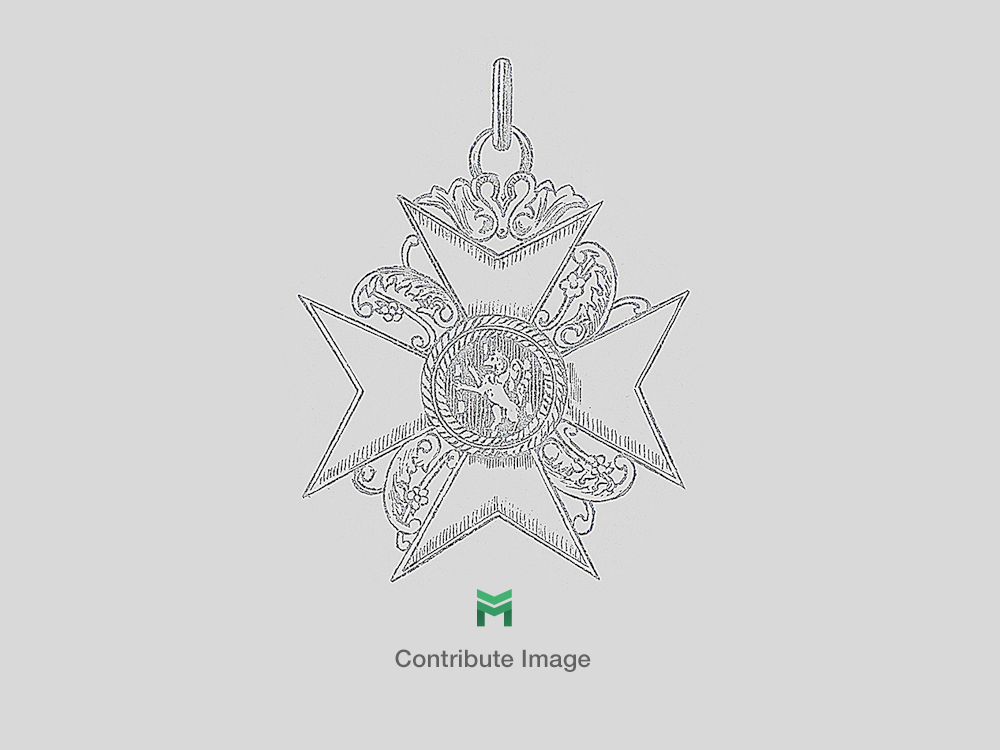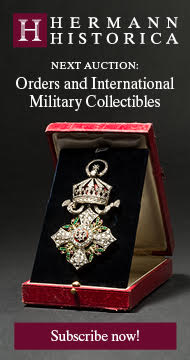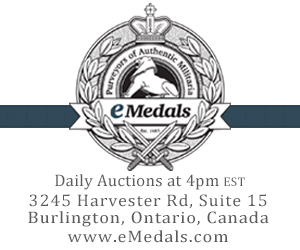German Army Tropical Veterinary Unteroffizier Shoulder Boards
SKU: 20.GOR.03.02.02.05.05.012
Estimated market value:

Estimated market value:
Attributes
Physical Description
Piping: carmine
History
Shoulder boards or straps were first and foremost used to identify a soldier’s rank. In certain cases they would also identify the soldier’s branch and unit, and potentially his specific role/career. For these purposes, shoulder boards often feature a branch colour, sometimes complimented by either a letter, a number, or a device, or any combination of these.
Shoulder straps were worn by lower ranks, whereas shoulder boards were worn by higher ranks. The difference lies in the quality of the material, the more elaborate look of the shoulder boards, and the fact that shoulder boards were padded and therefore more stiff, while shoulder straps generally were not. For the sake of simplicity, the terms will be used interchangeably.
Shoulder straps differ in size due to varying production methods and materials, how many numbers and letters they have to hold, and even the wearer’s shoulder size.
The first pattern shoulder strap was worn with the field blouse by all enlisted men and NCOs (non-commissioned officer) prior to 1938. In contrast to the second pattern’s round end at the buttonhole, this one has a pointed end. They are dark blue-green without piping. The branch colour would only appear if there was a number, letter, or device on the strap, and then only if these are embroidered. The second pattern was introduced on November 26, 1938.
While standard straps are either dark blue-green or field-grey, notable exceptions to this rule are the Panzer straps, which are black, and the Tropical straps, which are tan or sand-coloured. Panzer and Tropical shoulder straps only exist for the enlisted and NCO ranks. Officer and General shoulder boards are always of the standard variety.
Shoulder straps were either stitched to the uniform at the side without the button, or they were slipped on, held in place by a small strip of cloth. The other side was held by a button attached to the uniform.
Buttons of enlisted men and NCOs often have a number on them, either Roman or Arabic. A Roman number usually indicates a specific “Wehrkreis” (district), an Arabic number indicates a regiment or battalion.
Buttons are either field-grey, silver-coloured, or gold-coloured (for General ranks). Buttons for white camouflage uniforms were overpainted in white. Some late models of clothes used dark grey buttons.
The pips were made of silk or wool for enlisted men and lower NCO ranks (Unteroffiziere ohne Portepee), higher NCO ranks (Unteroffiziere mit Portepee) have white metal pips, Officer ranks have gold-coloured metal pips, and the pips for General ranks were made of high quality white or frosted silver metal.
Since it was costly in production time and material to produce new shoulder straps for all soldiers that were assigned to new units, during wartimes soldiers often received slip-on shoulder strap titles, pieces of cloth with unit designations in branch colours stitched onto them, that were simply slipped over the original shoulder strap. These were introduced on January 24, 1940.
Sometimes slip-on covers were worn over the shoulder straps for camouflage reasons. Some straps have regimental designators, thin coloured cords that were sewn horizontally across the base of the strap. It is not known why these designators were needed.
Specialist Officers (Sonderführer) wore shoulder cords (Schulterschnüre) instead of shoulder boards or straps. There were four different versions, depending on the rank.
Shoulder boards for Sonderführer were introduced in 1940, but then discontinued again in 1942.
Branch colours on German Heer headgear was as follows:
Black was worn by Engineer units.
Black/White was worn by Panzer Engineers.
Copper Brown was worn by Motorcycle personnel.
Light Brown was worn by Signals units until 1936, and by Construction troops.
Carmine was worn by the Führer Staff, General Staff Officers, Staff Officers of the Supreme Command of the Army, and all Veterinary branches.
Bordeaux Red was worn by Smoke & Chemical personnel.
Wine Red was worn by Judicial officials.
Bright Red was worn by Generals, Artillery units, and Ordnance Officers (until 1944).
Rose or Pink was worn by all Armored units (including Panzer troops, and Schützen Brigade Staff).
Orange was worn by Recruiting personnel, Ordnance troops, Ordnance Officers (since 1944), and Field Gendarmerie units.
Bright yellow was worn by Cavalry units, and Light Division Staff.
Lemon yellow was worn by Signal units.
White was worn by Infantry units.
Light Grey was worn by Propaganda personnel.
Grey-Blue was worn by Sonderführer (Specialist Officers).
Violet was worn by Chaplains and Field Bishops.
Cornflower Blue was worn by Medical units, and Supply units.
Bright Blue was worn by Transport troops.
Bright Green was worn by Jäger and Mountain units.
Grass Green was worn by Panzer Grenadier units (Armored Infantry).
Dark Green was worn by Administrative personnel.
This list gives a broad and somewhat simplified overview, since the branch colour system got more and more complex between 1936 and 1943. Also, different shades were produced due to varying dye lots and production processes.
Shoulder strap insignia of the German Heer were as follows:
Officers of the OKW (Supreme Command of the Wehrmacht), of the OKH (Supreme Command of the Heer), Generals, the Army Ordnance Director, Armoured Engineers, Military Field Police, Specialist Officers, and Army Propaganda troops did not wear any shoulder strap insignia.
Letters:
“A” with a unit number below was worn by Mounted Reconnaissance units on gold yellow, and by Motorized Reconnaissance on copper brown.
“B” with a unit number below on bright red was worn by Artillery Observation (Beobachter) units.
“D” and a divisional number below was worn by Infantry Divisional Staff on white, by Light Division Staff on gold yellow, by Armoured Division Staff on rose, and by Mountain troop Divisional Staff on bright green.
“Fl” on white was worn by Army Anti-aircraft (Flak) units.
“G” with a Group number below on white was worn by members of an Army Group command.
“GD” (entwined) on white was worn by members of the Infantry regiment “Großdeutschland”. It was introduced on July 20, 1939.
“GW” on white was worn by Mortar (Granatwerfer) battalions.
“HV” (with the V superimposed on the H) was worn by Administrative personnel on dark green (Heeresverwaltung = Army Administration).
“J” on rose was worn by Motor Maintenance troops.
“K” with a unit number below was worn by Motorcycle (Kradfahrer) units on white, on rose, and on grass green.
“L” was worn by Infantry training regiments on white, by Artillery training regiments on bright red, by Signals training regiments on lemon yellow, by Armoured training regiments on rose, by Smoke training units on bordeaux red, by Medical training units on cornflower blue, and by Transport training units on bright blue.
“M” with a unit number below on white was worn by Machine-gun battalions.
“MS” on rose was worn by members of an Army School of Motoring (Motorschule).
“P” with a unit number below on rose was worn by Anti-tank units.
“R” with a unit number below it was worn by Mounted Artillery units on bright red, and by Motorcycle units on gold yellow.
“RS” on gold yellow was worn by members of an Army Cavalry School (Reitschule).
“S” (Gothic) was worn by members of an Artillery School (Schule) on bright red, by members of an Infantry School on white, by members of a Cavalry School on gold yellow, by members of Armoured Schools on rose, by members of an Alpine and Mountain Troops’ School on bright green, by members of an Army Gas School and a Smoke troop School on bordeaux red, and by members of a Transport Supply School on bright blue.
“SS” (Gothic) on white was worn by members of an Army Sports School.
“T” on black was worn by Technical Officers.
“US” and the initial letter of the school was worn by members of NCOs’ Schools (Unteroffizierschule) on white, by members of an Artillery NCOs’ School on bright red, by members of Signals NCOs’ Schools on lemon yellow, and by members of a Pioneer NCOs’ School on black.
“W” with a Roman Wehrkreis number below on white was worn by Recruiting Office personnel.
Numbers:
A plain unit number was worn by Veterinary troops on carmine, by Artillery Regiments on bright red, by Cavalry units on gold yellow, by Signals units on lemon yellow, by Motorcycle units on copper brown, by Rifle Brigade Staff and Armoured units on rose, by Rifle and Mountaineering troops on bright green, by Armoured Infantry regiments on grass green, by Smoke units on bordeaux red, by Medical troops on cornflower blue, by Transport units on bright blue, and by Pioneer battalions on black.
A Wehrkreis number (Roman) was worn by members of the Veterinary research and inspection department on carmine, by members of an NCOs’ Preparatory School on white, by members members of a Military District Cavalry School on gold yellow, and by Recruiting personnel on orange.
A number of command (Roman) was worn by members of a General Command on white, and by members of a General Armoured Command on rose.
The number of their units on white was worn by Infantry regiments.
Devices:
Two crossed cannons on bright red were worn by Ordnance Officers.
A cog wheel on orange was worn by members of an Engineer Officer’s Academy.
A Kampfrune (Fighting Rune) with SA symbol, introduced in early 1943, was worn by the 60th Panzergrenadier Division “Feldherrnhalle”, to credit the fact that most of its members were originally in the SA.
A “Hoch- und Deutschmeister-Kreuz” cross, introduced on March 23, 1944, made of blue-grey metal, was worn by the Grenadier Regiment 134 replacement unit and Divisional Staff of the Reichsgrenadier Division “Hoch- und Deutschmeister”.
A hussar death’s head (Totenkopf) traditional insignia, as worn on the headgear. It was originally the insignia of the 1st and 2nd Leib Hussar Regiments. During the Nazi period the tradition was continued by the Regimental Staff of the 5th Cavalry Regiment and by squadrons 1, 2, 4, 5, and 11. All formations of the 4th Cavalry, except for the 41st Cavalry Regiment were also authorized for wearing it.
A lyre with a unit number below on the unit’s branch colour was worn by Bandmasters.
A lyre with a number (Arabic) of the school on white was worn by members of an Army School of Music.
A Mercury’s staff on cornflower blue was worn by Supply Officers.
A snake on carmine was worn by Veterinary Officers and NCOs.
A staff and serpent on cornflower blue was worn by Medical Officers and NCOs. Dentists wore an additional “Z” below.
A short sword was worn by Military Justice personnel.
This list covers the most common shoulder strap insignia, however it is not complete.
The addition of insignia to the shoulder straps may increase the price.
Enlisted men made up the lowest ranks of the Heer, namely the ranks of Soldat, Obersoldat, Gefreiter, Obergefreiter, and Stabsgefreiter. They wore a plain branch coloured cloth strap without any rank indication.
Enlisted men who were NCO or Officer candidates wore a slip-on or sew-on cloth braid horizontally across the base of the shoulder strap. This was introduced in 1942.
NCOs had an additional flat cloth braiding around the inner edge of the piping.
Stabsfeldwebel straps have three pips, one over two, forming a triangle. This rank was introduced on September 14, 1938.
Oberfeldwebel straps have two pips, one below the other.
Feldwebel straps have one pip.
Unterfeldwebel have no pips. The braiding of the Unterfeldwebel rank runs all the way around the strap, closing at the bottom.
Unteroffiziere have no pips. The braiding of the Unteroffizier rank is U-shaped and doesn’t close at the bottom.
Company Grade Officers’ (ranks Leutnant to Hauptmann) shoulder straps are slightly smaller in width and have two U-shaped strands of flat silver-coloured braids. Because of the way they are arranged, it looks like eight separate strands. This pattern is called “Russia Braid”.
Hauptmann straps have two pips, one above the potential insignia, one below.
Oberleutnant straps have one pip.
Leutnant straps have no pip.
Field Grade Officers’ (ranks Major to Oberst) straps, like Company Grade Officers, used the silver-coloured “Russia Braid” pattern, but with five loops on each side of the strap, as well as a single loop around the buttonhole.
Oberst straps have two pips.
Oberstleutnant straps have one pip.
Major straps have no pip.
General Officers wore the same “Russia Braid” looped pattern as Field Grade Officers, but their straps have two strands of gold-coloured braiding with one strand of silver-coloured braiding in between, and they only have four loops on each side.
Generalfeldmarschall straps have two crossed batons. A regulation from April 3, 1941 states that starting from this date, all three strands were supposed to be gold-coloured for the Generalfeldmarschall shoulder boards.
Generaloberst straps have three pips, one above two, forming a triangle.
General straps have two pips, one below the other.
Generalleutnant straps have one pip.
Generalmajor straps have no pip.
Reserve officers had a grey cloth underlay to their shoulder straps.


Comments
Sign in to comment and reply.


Scroll Top